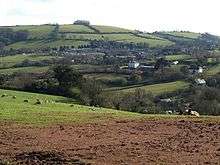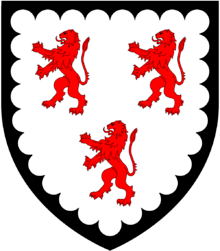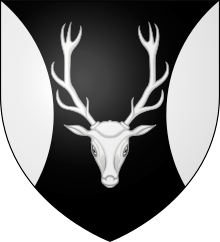Blagdon, Paignton

Blagdon historically in the parish of Paignton[1] in Devon, England (today in the parish of Collaton St Mary), is an historic manor, the seat of the Kirkham family from the 13th to 17th centuries. The manor house known as Blagdon Manor (House)[2] (or Blagdon Barton) survives as a grade II* listed building[3] about two miles west of the historic centre of the town of Paignton, situated behind the "Blagdon Inn" public house (former stables), and almost surrounded by the "Devon Hills Holiday Park" of caravans and mobile homes, set-back at the end of a short driveway off the A385 Paignton to Totnes road. The settlements or farms of Higher Blagdon, Middle Blagdon and Lower Blagdon are situated to the north of the manor house.
In the ancient Church of St John, the parish church of Paignton, survives the Kirkham Chantry Chapel, occupying the south transept, "without a doubt the chief interest of the church",[4] consisting of an elaborately sculped stone screen erected by the Kirkham family towards the end of the 15th century, with a further 16th century monument.
Descent
Kirkham

Sir John Kirkham (1472-1529) of Blagdon was Sheriff of Devon in 1523/4.[6] According to the Devonshire biographer Prince (d.1723), he was a "very free and liberal, ... prudent and discreet" benefactor of the town of Honiton in Devon.[7]
The senior male line ended on the death of Richard Kirkham (d.1631),[8] who married "the heiress of Oldham" near Tilbury in Essex,[9] and left a daughter and sole heiress Mary Kirkham, who married Sir George Blount, 2nd Baronet (died 1667) of Sodington in the parish of Mamble in Worcestershire. The younger brother of Richard Kirkham (d.1631) was Francis Kirkham who married the heiress of the Roope family of Bidwell in the parish of Newton St Cyres, Devon, where the Kirkham family continued for several generations.[10]
Blount
The eldest son of Mary Kirkham and Sir George Blount, 2nd Baronet (died 1667) was Sir Walter Kirkham Blount, 3rd Baronet (died 1717), who inherited his paternal estates, including Sodington. "The Blounts were notable for their faithful adherence to the Roman Catholic faith, and they gave the most zealous support to the Crown in the Civil War".[11] Her 3rd son was Edward Blount (d.1726) of Blagdon, who inherited his maternal estates.
Edward Blount as a Roman Catholic was associated with the Howard family, Dukes of Norfolk, the leading Catholic family in England. On 6th June 1716, together with Lord George Howard, (d.1721), the eldest half-brother of Henry Howard, 7th Duke of Norfolk (1655-1701), he "successfully petitioned the House of Lords for counsel to argue against provisions in the Papists' Estates Bill, read 18th May 1716, which threatened to ruin their credit".[12] Shortly thereafter Edward Blount went into exile with his family in Bruges, but had returned to England by 1721. In 1708 Edward Blount married Anne Guise, a daughter of Sir John Guise, 2nd Baronet (c. 1654–1695) of Elmore in Gloucestershire, which marriage was commemorated by the surviving heraldic overmantel above the fireplace of the great hall of Blagdon manor house. This shows the initials "EB" [13] and displays the arms of Blount (Barry nebuly of six or and sable) impaling Gules, seven mascles vair 3,3,1 (Guise) above a scroll inscribed with a Latin motto Lux Tua Via Mea ("Your light is my path") with the date "1708". In 1717 "Edward Blount of Blagdon", as a Roman Catholic, registered his landholdings under the Registration of Papists' Estates[14] legislation passed following the Jacobite uprising of 1715. Edward Blount was a friend and patron of the poet Alexander Pope (1688-1744),[15] and much correspondence between the two men during the years 1714-25 survives.[16] Both were Roman Catholics.[17]
Edward Blount left three daughters as his co-heiresses:
- Elizabeth Blount (d.1778), eldest daughter,[18] wife of Hugh Clifford, 3rd Baron Clifford of Chudleigh (1700-1732), of Ugbrooke in Devon.
- Henrietta Blount (d.1782), 2nd daughter, who married twice: firstly to Peter Proli of Antwerp;[19] secondly in 1739 to Philip Howard (d.1749/50), younger brother of Edward Howard, 9th Duke of Norfolk (1686-1777), by whom she had one daughter Anne Howard (1742-1787) (wife of Robert Petre, 9th Baron Petre (1742-1801)), who was excluded from inheriting the Dukedom of Norfolk (the premier dukedom of England) by a recent entail effected by the Act of Restoration 1664.
- Mary Blount (1701/2-1773),[20] 3rd daughter, who in 1727 married Edward Howard, 9th Duke of Norfolk (1686-1777), the most prominent Roman Catholic in England, but produced no progeny and heirs to the dukedom.[21] James Cook named Norfolk Island in honour of the Duchess of Norfolk in 1774, although he did not know at the time that she was already dead.
Parker

Blagdon remained a seat of the Blount family until it was acquired as his residence[23] by Francis Parker (born 1701-post 1757), the 4th son of George Parker (1651-1743) of Boringdon Hall, Plympton, and of North Molton, Devon, who purchased Saltram near Plymouth, later the principal seat of his descendants. Francis Parker of Blagdon left three daughters including:[24]
- Anne Parker, who married the banker John Baring (1730–1816), MP, of Mount Radford near Exeter, eldest brother of Sir Francis Baring, 1st Baronet. In 1757 her father (as "Francis Parker of Blagdon") entered into a marriage settlement on her behalf.[25]
- Elizabeth Parker, who married firstly to Thomas Baring of Larkbear, near Exeter, a younger brother of her sister's husband John Baring (1730–1816); secondly to William Spicer of Wear, thirdly to John Fryer of Exeter.[26]
Francis's heir was his elder brother John Parker (1703-1768) of Boringdon Hall, Plympton, and Saltram House, who in 1725[27] married Catherine Poulett (1706–1758), a daughter of John Poulett, 1st Earl Poulett, by his wife Bridget Bertie a granddaughter of Montagu Bertie, 2nd Earl of Lindsey. In 1763 John Parker leased Blagdon and other lands to his wife's relatives as is recorded on a deed in the Plymouth and West Devon Record Office summarised as follows:[28]
- "Lease for a year: 1) John Parker of Boringdon, esquire, eldest son and heir of George Parker, deceased. 2) Vere Poulett of Twickenham, Middx, esquire, and Ann Poulett of Albemarle Street, Westminster, esquire. Barton lands of Blagdon, Newparks, Oldaways and the Downs. Also manor of Collaton. Also lands of Edward Blount, deceased, in Paignton, Marldon and Stoke Gabriel. Also barton of Polsloe and two closes of land called Higher Bowmore and Lower Bowmore, parcel of Martyns tenement, Heavitree. Also barton of Oakhay alias Okey Place, Stoke Canon. Also all other lands in Paignton, Marldon, Stoke Canon, Heavitree and Stoke Gabriel that passed to John Parker as heir of Francis Parker. Also 1/8th of Herdwick alias Hardwick".
As John Parker's eldest son John Parker, 1st Baron Boringdon (1735-1788) inherited his paternal estates (North Molton, Boringdon and Saltram, etc.), Blagdon and Collaton Kirkham descended to John Parker's second son Montagu Edmund Parker (1737–1831) of Whiteway House,[29][30] near Chudleigh in Devon, Sheriff of Devon in 1789. Montagu's nephew was John Parker, 1st Earl of Morley (1772-1840), the son of his brother John Parker, 1st Baron Boringdon.
The public house in Collaton St Mary is called the "Parkers Arms" (sic) after the tenure of the Parker family.[31] A Funerary hatchment survives in St John's Church, Paignton, showing the arms of Parker (Sable, a stag's head cabossed between two flaunches argent, with a crescent for the difference of a second son) impaling: Azure, a fox passant proper in chief a sun.[32]
Hogg
In 1864 Rev. John Roughton Hogg (1811-1867), of Blagdon, Vicar of Torwood,[33] a Justice of the Peace for Devon,[34] (second son of Rev. James Hogg, Vicar of Geddington, Northamptonshire,[35] and master of Kettering grammar school),[36] commenced building (at his sole expense) the "evocative Victorian group" (Pevsner) of church, school and vicarage at the adjoining manor of Collaton (thenceforth "Collaton St Mary"), to the design of J.W.Rowell, to commemorate his daughter[37] Mary Maxwell Hogg (d.1864), who died aged 17 and was buried at Brixham and re-interred in his new church in 1867.[38] His diary between 1859-62 survives in the Devon Archives.[39] Hogg's wife was Anna Maria Maxwell Lyte (1822-1889), only daughter of Rev. Henry Francis Lyte (1793-1847) ,[40] of nearby Berry Head, Brixham, who composed the well-known hymns "Abide with me", "Praise my soul the King of Heaven" and "Pleasant are thy courts above". The inscribed Hogg Memorial erected by him in 1867 and situated 6 metres south of the chancel wall, is a grade II listed structure made of white Italian marble on red breccia base with a marble cross on a 3-tier plinth with breccia base with red breccia kerbs.[41]
Until that time the parish church of Blagdon had been St John's Church in Paignton, the mediaeval parish church in which is situated the Kirkham Chantry Chapel. Other new churches were built at that time in and around Paignton and Torquay to cater for the greatly expanded populations due to the development of the Torbay area as a seaside resort.
Further reading
- Amery, P.F.S., Notes on Blagdon Barton, near Totnes and its owners, Transactions of the Devonshire Association, Vol. 32, 1900, pp.296-300.
Sources
- Pevsner, Nikolaus & Cherry, Bridget, The Buildings of England: Devon, London, 2004, pp. 839, 844
- Pole, Sir William (d.1635), Collections Towards a Description of the County of Devon, Sir John-William de la Pole (ed.), London, 1791, p. 279
- Vivian, Lt.Col. J.L., (Ed.) The Visitations of the County of Devon: Comprising the Heralds' Visitations of 1531, 1564 & 1620, Exeter, 1895, pp. 516–17, pedigree of Kirkham of Blagdon
- Listed building text, Blagdon Manor, Paignton
References
- ↑ Pole, p.279
- ↑ Pevsner, p.844
- ↑ Listed building text, Blagdon Manor, Paignton
- ↑ Pevsner, p.838
- ↑ Pole, p.490
- ↑ Prince, John, (1643–1723) The Worthies of Devon, 1810 edition, London, p.555, biography of Kirkham, Sir John, Kt
- ↑ Prince, p.556
- ↑ Vivian, p.517
- ↑ Prince, John, (1643–1723) The Worthies of Devon, 1810 edition, London, p.555, biography of Sir John Kirkham (1472–1529)
- ↑ Vivian, p.517
- ↑ Parishes: Mamble', in A History of the County of Worcester: Volume 4, ed. William Page and J W Willis-Bund (London, 1924), pp. 285-289. British History Online http://www.british-history.ac.uk/vch/worcs/vol4/pp285-289
- ↑ quoting sources: HMC, Manuscripts of the House of Lords, Vol. 11, 1714-1718, no. 3979, p. 290, Main Papers
- ↑ Pevsner, Nikolaus & Cherry, Bridget, The Buildings of England: Devon, London, 2004, p.844
- ↑ Devon Heritage Centre
- ↑ Further reading see: Mack, Maynard, Alexander Pope - A Life
- ↑
- ↑ Letter dated Aug 27 1714 from Edward Blount
- ↑ Vivian, p.196, pedigree of Clifford
- ↑ Apparently a member of the Dutch trading house of Proli & Arnoldt of Antwerp, granted by 1750 decree of Maria Theresa the right to found a sugar company in Trieste
- ↑ Oxford Dictionary of National Biography
- ↑ Debrett, John, Baronetage of England
- ↑ Summers, Peter & Titterton, John, (eds.), Hatchments in Britain, Vol.7: Cornwall, Devon, Dorset, Gloucestershire, Hampshire, Isle of Wight and Somerset; Phillimore Press, Chichester, Sussex, 1988, p.28
- ↑ Vivian, p.588, pedigree of Parker "Francis Parker of Blagdon"
- ↑ Burke, 1845, p.703
- ↑ Devon Archives, ref:1926 B/B/L/5/1, Description: Lease for lives: 1. Francis Parker of Blagdon, esq.; 2. John Baring of Mount Radford, esq. Marriage settlement of John Baring and Anne, daughter of Francis Parker
- ↑ Burke, John Bernard, Genealogical and Heraldic Dictionary of the Peerage and Baronetage of the British Empire, 8th Edition, London, 1845, p.703, Earl of Morley
- ↑ NT guidebook, Saltram House, p.65
- ↑ Plymouth and West Devon Record Office, ref:69/M/2/641
- ↑ Incorrectly stated to have purchased these lands in Risdon, Tristram (d.1640), Survey of Devon, 1811 edition, London, 1811, with 1810 Additions, p.378
- ↑ Risdon, Tristram (d.1640), Survey of Devon, 1811 edition, London, 1811, with 1810 Additions, p.378
- ↑ 2017 pub sign displays wrong arms for Parker
- ↑ Hanging high on south wall of nave; Possibly for John Parker (d.1847), 2nd grandson of Montagu Edmund Parker I, who died without progeny (Vivian, p.588). Further reading see: Summers, Peter & Titterton, John, (eds.), Hatchments in Britain, Vol.7: Cornwall, Devon, Dorset, Gloucestershire, Hampshire, Isle of Wight and Somerset; Phillimore Press, Chichester, Sussex, 1988
- ↑ http://discovery.nationalarchives.gov.uk/details/c/F42712
- ↑ Alumni Cantabrigienses
- ↑ Gentleman's Magazine September 1846 p314
- ↑ https://en.wikisource.org/wiki/Nettleship,_John_Trivett_(DNB12)
- ↑ Pevsner, p.839
- ↑ Listed building text "Hogg Memorial"
- ↑ Ref:4826 Z/17
- ↑ http://www.devonhistoricchurches.co.uk/index.php?page=collaton-st-mary
- ↑ Listed building text "Hogg Memorial"